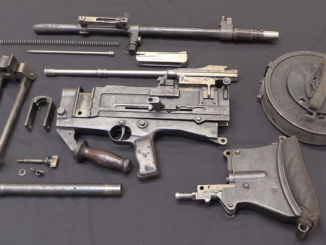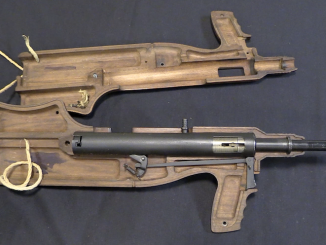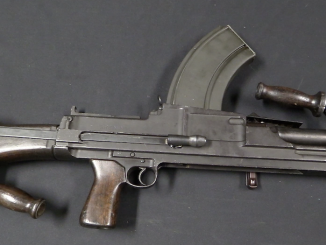Available from Amazon:
Available from Collector Grade Publications:
Since we are in the midst of an ongoing video series looking at the development of the SA80 weapons family, I figured this would be a good time to mention the single best source of written information on that program: Steve Raw’s book “The Last Enfield: SA80 The Reluctant Rifle”. Published in 2003 by Collector Grade Publications, this roughly 300 page work covers the SA80 program from its very earliest beginnings through the Enfield Weapons System days (in 4.85mm), the transition to the 5.56mm SA80, troop trials, adoption, the Gulf War revelations of its problems, and the HK A2 redesign.
As one would expect of a Collector Grade book, this work is extremely thorough, showing in detail the design changes that were made and explaining their circumstances. Its covers not just the standard L85 Individual Weapon and L86 Light Support Weapon, but also the various special models that were prototyped (carbines, grenade launchers, etc) as well as accessories like blank firing adapters and bayonets (and much more).
Until you read through The Last Enfield, you will not fully realize the catastrophe that was SA80. It is truly mind boggling just how badly wrong this weapon’s development path went. Each chapter is a new litany of disasters, as the gun in many ways became (unbelievable as this may be) worse as it progressed through development and trials. For anyone interested in weapons design and military procurement, this is an essential story to know, and The Last Enfield is without any doubt the one comprehensive explanation of that story.
Available through Amazon (below) or Collector Grade Publications.




“It is truly mind boggling just how badly wrong this weapon’s development path went.”
I am wondering how it would compare against other failed weapons of British origin, like K-class submarine (also known Kalamity-class) used during First World War, SaRo Lerwick flying boat and Blackburn Botha torpedo bomber (both used during WWII) or A22 Infantry Tank, which has some reliability issues initially, but finally it worked as intended.
What was common for all these development and what was different?
the Churchill only got a bad rep because they were dumped on a beach at Dieppe and expected to somehow climb over a sea wall whilst under fire from anti-tank guns. By 1942 most of the kinks had been sorted out and it gave a good account of itself in Africa, even disabling Tiger’s.
It was pretty much designed and in service within the year, which lead to multiple issues with reliability and build quality.
Its a similar story with the Crusader and Covenanter, both were ordered off the drawing board and went straight into production as the need for tanks was so great. The Covenanter was a bit of a disaster and could only really operate within the UK due to the engine overheating. The Crusader was a good tank, but it was rushed in production, as soon as they got to Africa they were basically stripped and everything was refitted. The problem with the Crusader was the Liberty engine, and its small size which meant a Meteor could not be fitted and it could not accomodate a larger weapon without a complete redesign and a drastic reduction in crew size.
Its seems like a historical trend that the army was always at the bottom of the pecking order. The Navy and airforce always took priority and took all the the talent too.
“Its seems like a historical trend that the army was always at the bottom of the pecking order. The Navy and airforce always took priority and took all the the talent too.”
This is logical if you consider that Great Britain is island and thus anyone trying to conquer need to cross water
See Amazon translated $50 for the book to £73 on our benighted shores (UK). What a gang of rip off merchants. I know Brexit has hit the pound but even by Amazon standards this is shocking. Bought one at Abe Books for a more reasonable £42.
Thanks for the good work on the series Ian. I know that you ameliorated your comments on the project engineers by saying they did not understand guns, but I would not let that bunch loose on a pencil sharpener.
The part that keeps boggling my mind is how did 20+ engineers all get jobs at a palce with “Small Arms Factory,” in the name when they didn’t have any small arms experience?
If we’re talking about just British armaments procurement, the major problem has always been that the governments have followed a policy of never adopting a “trade” item (which would involve paying royalties on patented features, etc.) if a government run establishment can come up with a workable alternative. Note that in this context, “workable” is a highly subjective word.
One example was the two Enfield revolvers, the MK I .476 of 1879 and the more familiar Enfield .380in of WW2. The old .476 used a clumsy extraction system based on an American patent by one Owen Jones to avoid paying royalties to either Webley & Scott or Smith & Wesson;
http://i163.photobucket.com/albums/t320/Nyles303/Handguns/SDC10285.jpg
The WW2 Enfield was a topbreak cross between a Webley and an Iver Johnson, mostly IJ in its searage, and noted for its horrendous trigger.
During WW 1, to avoid paying royalties to Frederick Martin Hale and the Cotton Powder Co. of Faversham, Kent, on the Hale-pattern hand and rifle grenade, the government introduced the Grenade, Hand, Number 1, which replace the inertial striker detonator of the Hale with a “direct action” detonator;
http://c8.alamy.com/comp/DR1NBP/hand-grenade-mark-i-world-war-one-1-british-army-issue-DR1NBP.jpg
Both were handled the same way, but the No. 1 had the unfortunate drawback in trench warfare that if it was struck against the backside of the trench in the windup, or simply dropped on its business end, it would detonate. The Hale’s inertial striker had been designed with a creep spring built in specifically to prevent such accidents;
http://www.bocn.co.uk/vbforum/attachments/no_2_mk1.jpg
In the end, as you might already have guessed from the “No. 2 Mk. 1” label, the British government ended up replacing the insanely dangerous (to its users) No. 1 with the less touchy Hale anyway.
Probably the most egregious example of this was the entire wretched R.101 airship business. In which the Labour government was so determined to prove that a government-run establishment could build a better LTA than a private one (to justify outlawing the existence of the private one- they were socialists, after all) that they built an airship so amazingly badly designed, underpowered, and poorly built that it crashed in France while taking the new British Viceroy to India.
I don’t have room for the whole story (which borders on black comedy in places), but you can get an insider view of it by reading the relevant chapters of Slide Rule by Nevil Shute (Norway), who worked on the competing (private) R-100 under Barnes Wallis, of WW2 “Dam Buster” bomb fame.
The U.S. approach has generally been to use the best available design regardless of who comes up with it. One time we didn’t was in the post-Civil War period, when we adopted the Trapdoor Springfield rifle simply because Erskine Allen, the director of Springfield Armory, proposed it claiming it as his own invention and not charging the Army any royalties. In fact, it was a copy of the Berdan (I) breech already being used in Russia at that time, and Allen neglected to mention that little detail- which was to cost the U.S. government a lawsuit by Hiram Berdan’s widow.
Not to mention the fact that the Trapdoor was and is so weak as to be dangerous even with service .50-70 or .45-70 ammunition, not “high-pressure” by any means.
The Remington rolling block is famed for being so strong that the barrel invariably splits in a high-pressure event before the breech lets go. In the Trapdoor, the breech always blows before the barrel fails, right in the shooter’s face, and often does it with standard service loads.
In a rare burst of sanity, at the same time, the British government adopted the Snider conversion breech, a side-opening steel “block” in a steel “box”, that couldn’t blow before the barrel does unless you loaded it with nitroglycerin. A Snider blowup would require steel to compress upon steel, which just doesn’t happen at black-powder pressures.
Jacob Snider, BTW, was an engineer at Springfield- before Allin had him fired to keep him from presenting his breech design to the committee examining potential breech systems.
The British government then moved on to the Martini-Henry- which was a Peabody action they copied without paying any royalties, even to Friedrich von Martini or Alexander Henry.
Seen in the light of the above, the history of the Enfield “bullpup” rifle, from its start as a hockshop AR-18 action copy designed by people with no experience in rifle design, to its spectacular failure in service, shouldn’t really surprise anybody.
It’s just business as usual for the British government.
clear ether
eon
“In fact, it was a copy of the Berdan (I) breech already being used in Russia at that time”
Although in Russian service it was used only in limited numbers and it was soon replaced by Berdan II (1870) which was single-shot bolt-action rifle and used more powerful cartridge.
https://ru.wikipedia.org/wiki/Винтовка_Бердана has following data.
Quantity of rifles @ 1 January 1877:
Berdan No2 (1870) – 253 152 in service and 103 616 in reserve
Berdan No1 (1868) – 17 810 in service and 10 104 in reserve
Krnka (1868)* – 413 297 in service and 192 866 in reserve
Albini-Baranov (1868)*,** – 3 691 in service and 6 309 in reserve
Карле (1867)* – 150 868 in service and 51 096 in reserve
Terry-Norman (1866)* – 4 126 in service and 7 874 in reserve
* – conversion muzzle-loading to breech-loading
** – used by Imperial Russian Navy only
“It’s just business as usual for the British government.”
I am wondering why not some NATO countries, which feel need for 5,56 rifle, does not make common program, like Eurofighter Typhoon?
That was more or less the intent behind the Heckler & Koch G36 “plastic” rifle. Unfortunately, it and its American stepchild, the XM8, turned out so amazingly horrid (they tend to actually melt after two or three magazines’ worth of four-shot bursts, and let’s not even talk about what happens to the LSW version with a 150-round double drum), that even the Bundesheer dropped the wretched thing;
https://en.wikipedia.org/wiki/Heckler_%26_Koch_G36
Put simply, if the air temperature is over 85 degrees F, you’re not going to like what happens when you try to fire a G36.
cheers
eon
At risk of serious repetition,
Interests within the british state were extremely upset when news of how bad the rifle was, got published after the first war against Saddam in the early 1990s.
Does anyone know if Jan Stevenson is still with us?
This should be a textbook – for engineering and management students – about the disadvantages of ‘design by committee.’
“disadvantages of ‘design by committee.’”
Sturmpanzerwagen A7V might be example of failed design done by committee
http://www.landships.info/landships/tank_articles.html#
Wrong link, should be: http://www.landships.info/landships/tank_articles.html?load=tank_articles/A7V.html
Years back, I remember reading James Edmiston’s book “The Sterling Years”. Sterling Armaments were making the AR18, and thought they could tweak the design a bit. Gene Stoner told them not to touch a thing. He had made it to work just the way it was. Along came Enfield and turned it into a bullpup! No wonder they had problems.
It would have made sense for Britain to have just bought the AR18s made by Sterling. However, the MoD bureaucrats hated Sterling. This was because they had been making Sterling SMGs in Royal Ordnance factories without paying royalties. James Edmiston eventually managed to get the money he was owed, but they never forgave him, and ruined him and Sterling in a bogus legal case about supplying arms to Iraq, for which he eventually received compensation.
But Sterling Armamenst is gone, the Royal Ordnance factories are closed, and Britain now has no capacity to make small arms for its military. What a shocking and reprehensible state of affairs, brought about by malice and incompetence in the government bureaucracy.
The only happy part of the story is that James Edmiston is still in the gun trade, making English shotguns. At least Britain can still do that.